The Intel Core i3-7350K (60W) Review: Almost a Core i7-2600K
by Ian Cutress on February 3, 2017 8:00 AM ESTLegacy and Synthetic Tests
At AnandTech, I’ve taken somewhat of a dim view to pure synthetic tests, as they fail to be relatable. Nonetheless, our benchmark database spans to a time when that is all we had! We take a few of these tests for a pin with the latest hardware.
Cinebench R10
The R10 version of Cinebench is one of our oldest benchmarks, with data going back more than a few generations. The benchmark is similar to that of the newest R15 version, albeit with a simpler render target and a different strategy for multithreading.
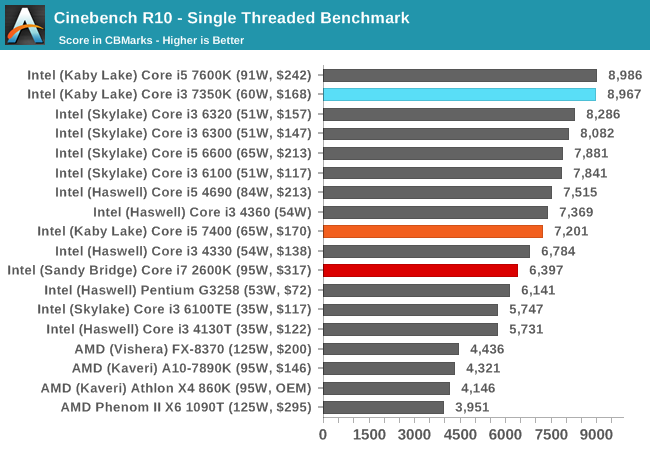
With high frequency in tow, the Core i3-7350K makes its mark.
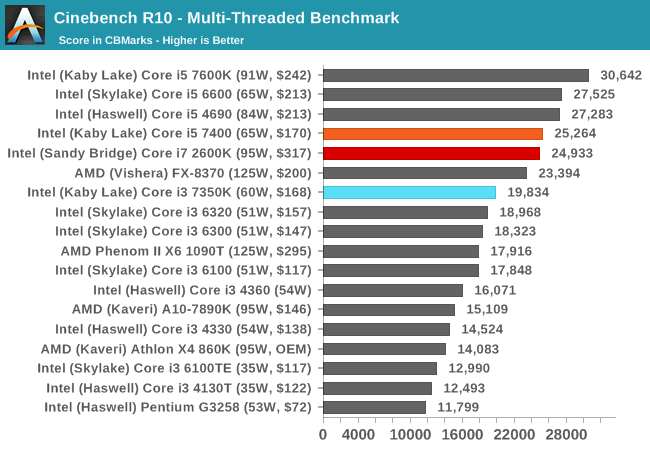
When more threads come to play, the Core i5-7400 and Core i7-2600K battle it out in terms of four cores and IPC vs hyperthreading. The Core i3-7350K sits around ~25% behind.
Cinebench R11.5
CB11.5 has been popular for many years as a performance test, using easy to read and compare numbers that aren’t in the 1000s. We run the benchmark in an automated fashion three times in single-thread and multi-thread mode and take the average of the results.
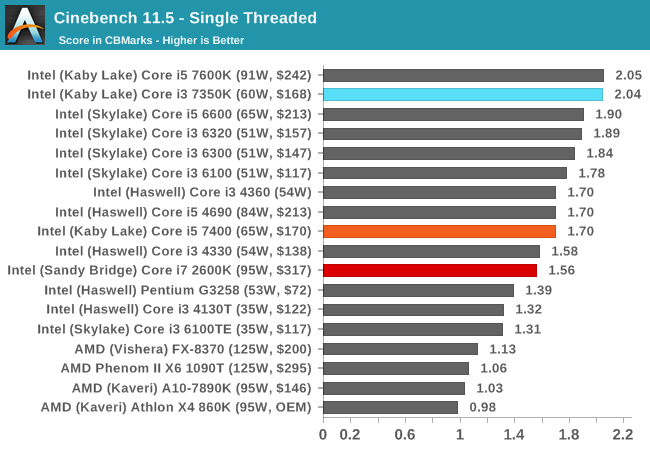
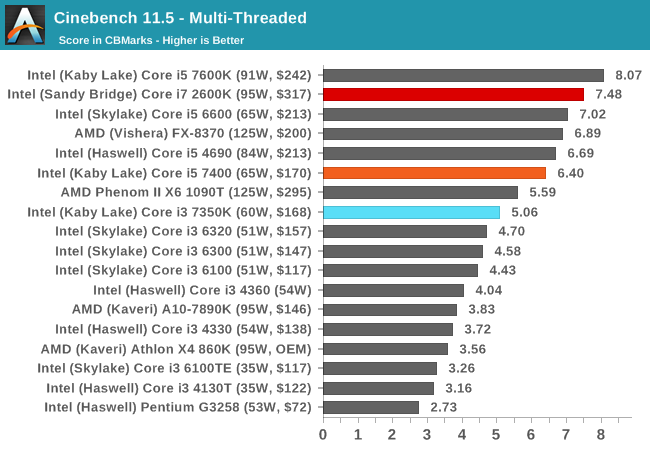
Similar to CB10, the single thread results show that a 4.2 GHz Kaby Lake is nothing to be sniffed at. In the multithreaded test, CB11.5 is more able to leverage the hyperthreads, showing that a Core i7-2600K will run rings around the low end Kaby i5, but is bested by the higher frequency Kaby i5-K. The Core i3 still has that dual core deficit.
7-zip
As an open source compression/decompression tool, 7-zip is easy to test and features a built-in benchmark to measure performance. As a utility, similar to WinRAR, high thread counts, frequency and UPC typically win the day here.
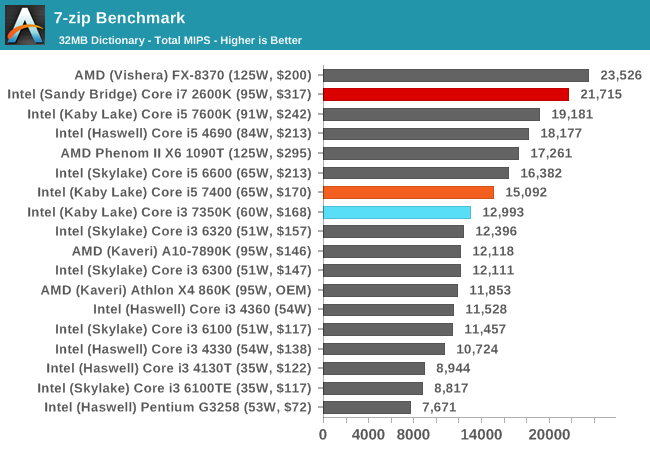
The difference between the i3-7350K and the i5-7400 shows that 7-zip prefers cores over threads, but the Core i7-2600K results show it can use both to good effect, even on older microarchitectures, scoring almost double the i3-7350K.
POV-Ray
Ray-tracing is a typical multithreaded test, with each ray being a potential thread in its own right ensuring that a workload can scale in complexity easily. This lends itself to cores, frequency and IPC: the more, the better.

POV-Ray is a benchmark that is usually touted as liking high IPC, high frequency and more threads. The i7-2600K, despite having double the resources of the Core i3-7350K, is only 30% ahead.
AES via TrueCrypt
Despite TrueCrypt no longer being maintained, the final version incorporates a good test to measure different encryption methodologies as well as encryption combinations. When TrueCrypt was in full swing, the introduction of AES accelerated hardware dialed the performance up a notch, however most of the processors (save the Pentiums/Celerons) now support this and get good speed. The built-in TrueCrypt test does a mass encryption on in-memory data, giving results in GB/s.
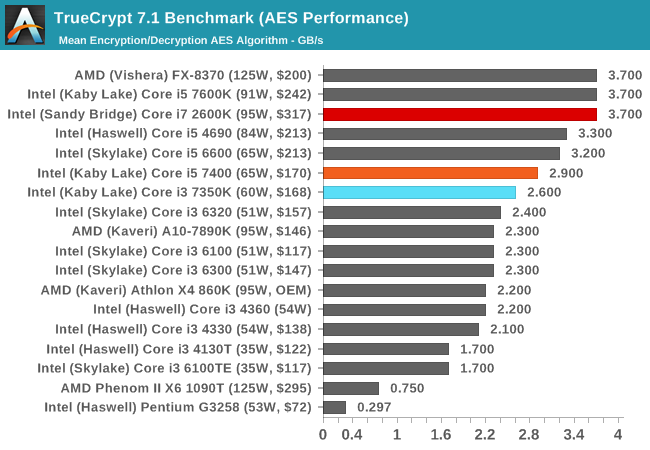










186 Comments
View All Comments
Bullwinkle J Moose - Sunday, February 5, 2017 - link
Correction: Can I record what I hear on the desktop with the DRM crippling API's found in Windows Vista / 7 / 8 and 10 ?should be > Can I record what I hear on the desktop with the DRM "crippled" API's found in Windows Vista / 7 / 8 and 10 ?
The API's do not cripple the DRM
The DRM does all the crippling !
Bullwinkle J Moose - Sunday, February 5, 2017 - link
Finally got Optical SPDIF working in both Windows 8.1 AND Windows 10 after that rant above!Yes, I Really did think that was a DRM issue
My original USB Soundblaster had optical in and out disabled in software updates after all the hysterical copyright violation complaints
Meteor2 - Sunday, February 5, 2017 - link
RE: why are there no 150-200W consumer CPUs. Because there's no consumer software which could take advantage of 24C/48T CPUs, unlike GPUs.Of course, if you want a 150W CPU, you can buy a big Xeon. But there's not a lot of software out there which can make use of them.
The_Assimilator - Monday, February 6, 2017 - link
Should've rather used an i5-2500K in the comparison; 2c/4t vs 4c/4t is fairer than 4c/8t. Although, a real comparison at 4.6GHz on both chips (or whatever the i3 can hit) would see the KBL obliterated regardless.evilpaul666 - Wednesday, February 8, 2017 - link
I think they said they're working on an overclocking article, but I agree the i5-2500K with both chips overclocked would have been a much more interesting test.Anato - Monday, February 6, 2017 - link
Intel should make all K-processors fully enabled, HT, ECC, Cache and sell them cheaply as 2.0-3GHz parts. Then give user tools to make changes to cache, ECC etc and after that its users task to find out what CPU can do. That would bring back good old days and Intel could get rid of cores that are otherwise unsellable.Still no need to upgrade from Sandy Bridge i5-2500k and just bought GTX 1080 for it.
evilpaul666 - Wednesday, February 8, 2017 - link
So is Optane ever actually coming out? And is it going to actually work as a 16/32GB cache for mechanical storage the ~1500/500 read/write speeds I saw quoted for it a while back would be nice as a cache for HDDs, but are slower than NVMe drives at this point.evilspoons - Wednesday, February 8, 2017 - link
Well, I guess I'm *still* sitting on my i7-2600k overclocked to 4.6 GHz. I pushed it from stock clocks in ~2013 assuming I'd replace it soon but four years later it's still ticking along just fine and I still don't have a compelling upgrade path!ANobody - Wednesday, February 8, 2017 - link
Slow is the death of IPC progress. Painful to watch.Ubercake - Friday, February 10, 2017 - link
I would hope an i3 marketed as 5 generations later could match an i7 from 5 generations before?Intel has had the market cornered for too long...